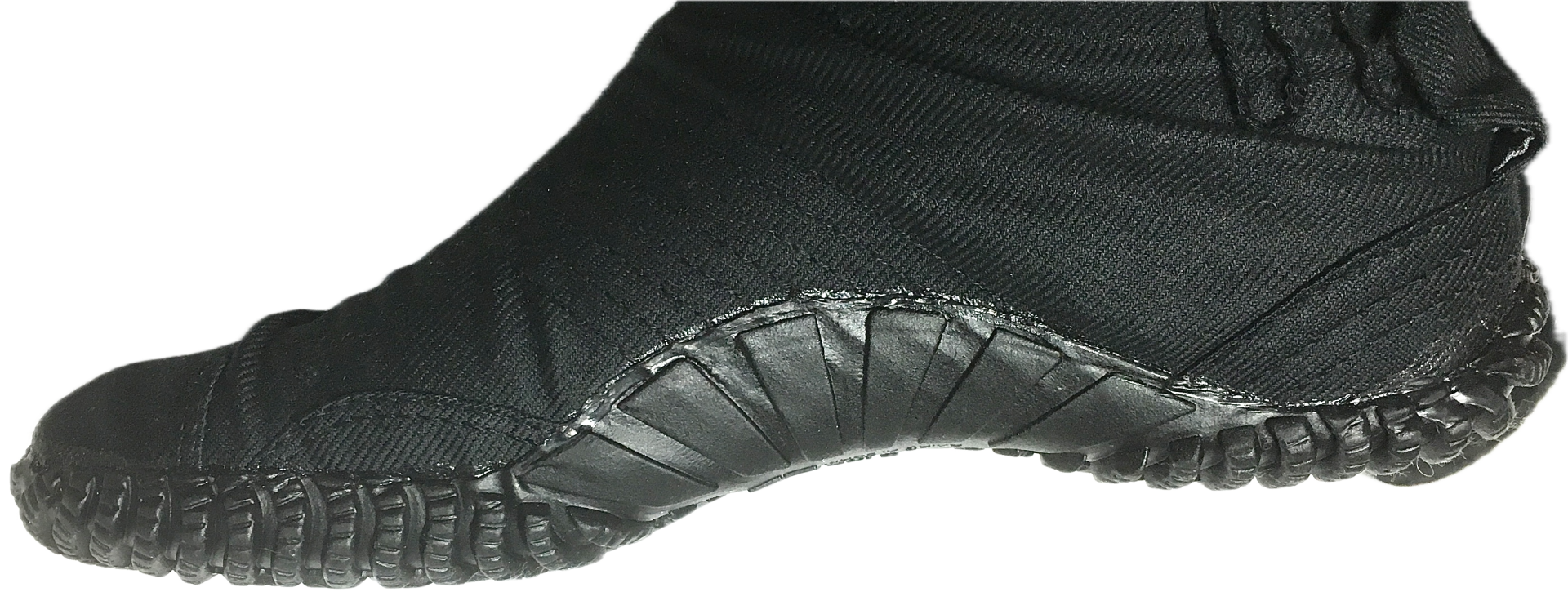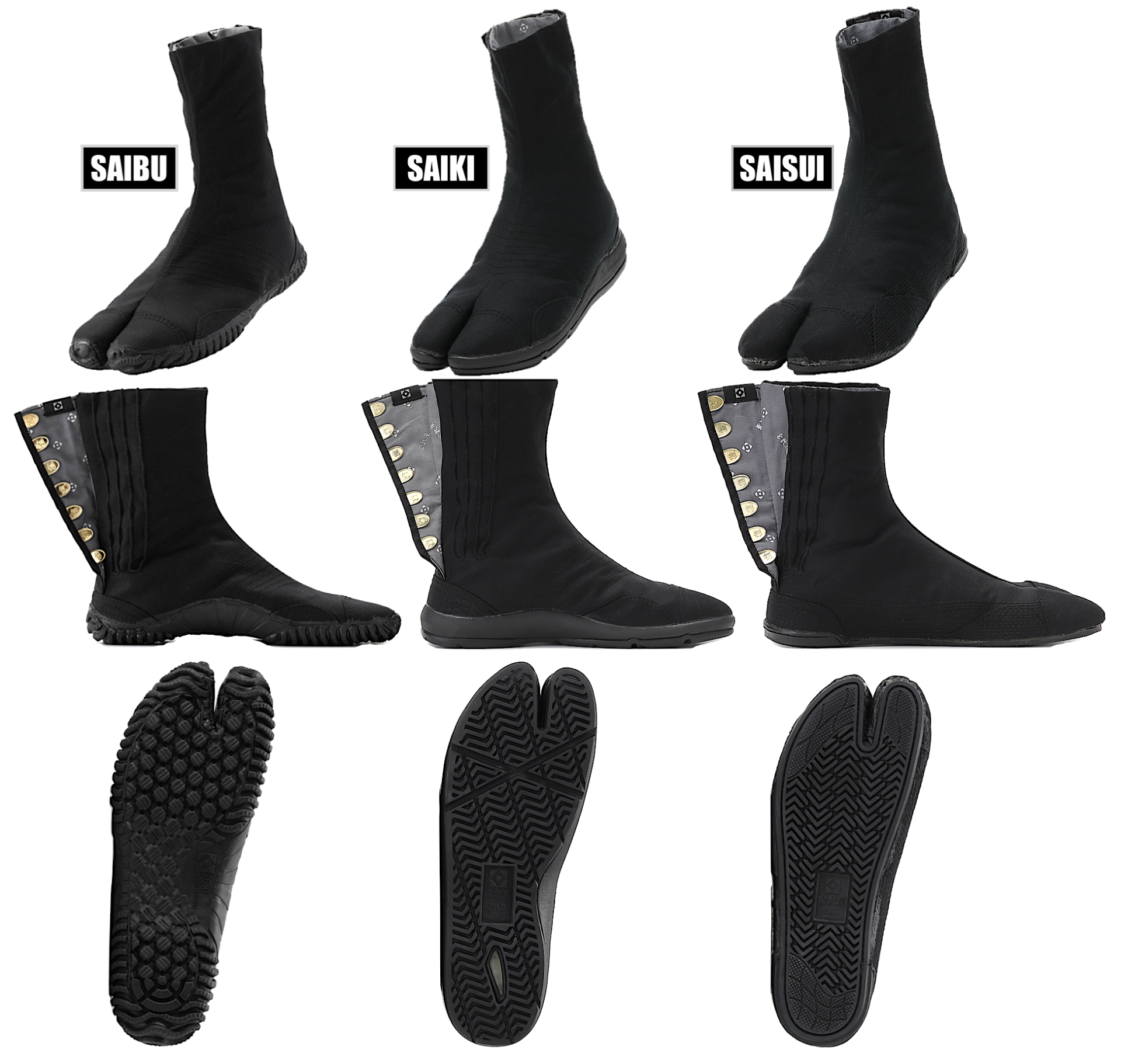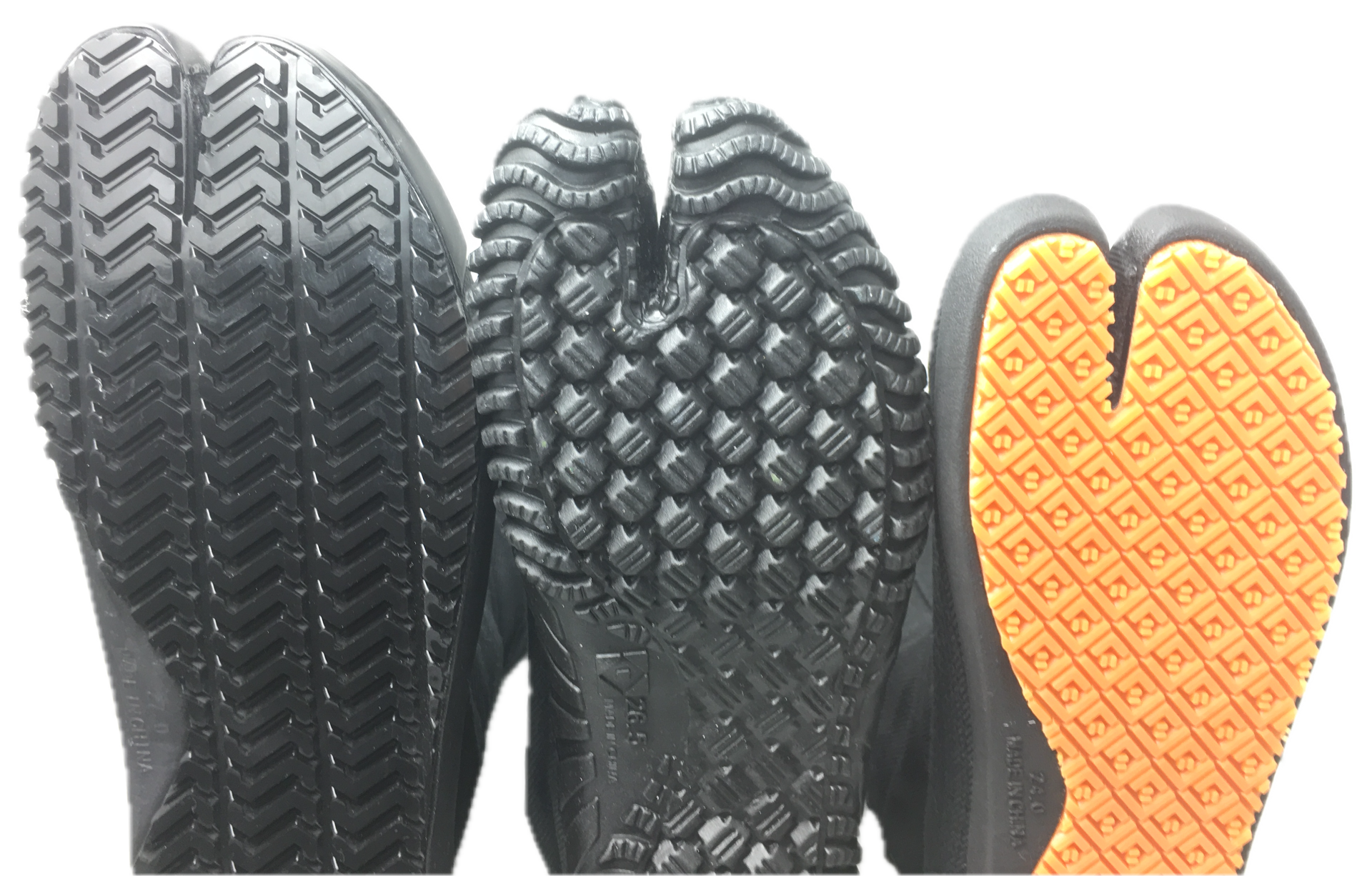In the practice of Ninjutsu, choosing the right pair of Jikatabi is crucial for ensuring optimal performance and maximum comfort. Jikatabi, with their unique design and specific functionality, are much more than just footwear. They are essential equipment that can significantly influence your efficiency during training and demonstrations.
Today, we present a detailed comparison of three popular Jikatabi models: the Saibu, the Saiki, and the Saisui. Each of these models has unique features and specific advantages that cater to different needs and preferences of Ninjutsu practitioners.
We invite you to read this article to discover the differences between these models and make an informed choice based on your specific needs. Whether you are an experienced practitioner or new to the art of Ninjutsu, our guide will help you find the ideal Jikatabi to enhance your practice and achieve your martial arts goals.

Choosing the Right Jikatabi for Ninjutsu Practice:
A Comparison of Saibu, Saiki, and Saisui Models
1. Presentation of Jikatabi Models
Jikatabi are traditional Japanese shoes that have been adapted for modern use, particularly in martial arts like Ninjutsu. Unlike conventional shoes, Jikatabi feature a split-toe design that enhances balance, agility, and tactile feedback. This unique design allows practitioners to move with greater precision and control, essential qualities in Ninjutsu where swift, silent movements are often required.
Jikatabi are generally made from durable materials such as cotton canvas and feature sturdy soles that provide excellent grip on various surfaces. They are fastened using traditional "kohaze" hooks, which ensure a snug and easy fit. This combination of traditional craftsmanship and modern functionality makes Jikatabi an indispensable part of a Ninjutsu practitioner's gear.
Importance of Specific Features for Ninjutsu Practice and Progression
The specific features of Jikatabi play a crucial role in the practice and progression of Ninjutsu, especially when considering different levels, types, and locations of training.
- Split-Toe Design: This design not only improves balance and agility but also enhances proprioception, allowing practitioners to better feel the ground and adjust their movements accordingly. This is particularly important for beginners who are still developing their sense of balance and coordination.
- Durable Materials: High-quality cotton canvas and reinforced stitching ensure that Jikatabi can withstand the rigors of intense training. This durability is essential for practitioners of all levels, as it ensures the shoes will last through many training sessions.
- Grip and Traction: The soles of Jikatabi are designed to provide excellent grip on a variety of surfaces, from dojo floors to outdoor terrains. This is crucial for executing techniques safely and effectively, whether you are training in a controlled indoor environment or out in nature.
- Adjustable Fit: Traditional "kohaze" hooks allow for a customized fit, ensuring that the Jikatabi stay securely on your feet during dynamic movements. This feature is particularly beneficial for advanced practitioners who perform complex and rapid techniques.
- Versatility: Different Jikatabi models are tailored for various types of training and environments. For example, some models are designed for rugged outdoor use, with thicker soles and additional reinforcements, while others are optimized for indoor practice with lighter materials and more flexible construction.
By understanding the importance of these specific features, practitioners can choose the Jikatabi model that best suits their training needs and environments. Whether you are training in the forest, on flat terrain, or in a dojo, selecting the appropriate Jikatabi will help you improve your skills and progress more effectively in your Ninjutsu practice.

Comparison Table of Jikatabi Models: Saibu, Saiki, and Saisui
Here is the updated comparison table for the three Jikatabi models, including ratings in gold stars for quality, durability, lightness, minimalism, and anti-slip stability.
| Characteristics |
Saibu |
Saiki |
Saisui |
| Sole |
Anti-slip, rugged |
Semi-anti-slip, chevron pattern |
Semi-anti-slip, chevron pattern |
| Closure Type |
7 brass "kohaze" hooks |
7 brass "kohaze" hooks |
7 brass "kohaze" hooks |
| Upper Material |
Cotton canvas |
Cotton canvas |
Cotton canvas |
| Side Reinforcements |
Yes, reinforced for better durability |
Yes, lightweight for more flexibility |
Yes, lightweight for more flexibility |
| Heel Reinforcements |
Yes, for increased stability and protection |
Yes, for moderate stability |
Yes, for moderate stability |
| Top Foot Reinforcements |
Yes, for protection during kicking techniques |
Yes, but more flexible for comfort |
Yes, but more flexible for comfort |
| Recommended Use |
Rugged terrain, intensive training |
Everyday use, varied terrains |
Everyday use, varied terrains |
| Comfort |
High comfort for long training sessions |
Moderate comfort for daily use |
Moderate comfort for daily use |
| Durability |
Very high durability |
High durability |
High durability |
| Types of Ninjutsu Use |
Walking, running, jumping, climbing, parkour, kicking techniques |
Walking, running, kicking techniques |
Walking, running, kicking techniques |
| Types of Terrain |
Forest, rugged terrain, varied terrains |
Flat terrain, varied terrains |
Flat terrain, varied terrains |
| Quality |
⭐⭐⭐⭐⭐ |
⭐⭐⭐⭐ |
⭐⭐⭐⭐ |
| Durability |
⭐⭐⭐⭐⭐ |
⭐⭐⭐⭐ |
⭐⭐⭐⭐ |
| Lightness |
⭐⭐⭐ |
⭐⭐⭐⭐ |
⭐⭐⭐⭐ |
| Minimalism |
⭐⭐⭐⭐ |
⭐⭐⭐⭐⭐ |
⭐⭐⭐⭐⭐ |
| Anti-Slip Stability |
⭐⭐⭐⭐⭐ |
⭐⭐⭐⭐ |
⭐⭐⭐⭐ |
Comparison Table of Jikatabi Models: Saibu, Saiki, and Saisui
Comparison Table of Jikatabi Models: Saibu, Saiki, and Saisui
Here is the updated comparison table for the three Jikatabi models, including ratings in gold stars for quality, durability, lightness, minimalism, and anti-slip stability.
| Characteristics |
Saibu |
Saiki |
Saisui |
| Sole |
Anti-slip, rugged |
Semi-anti-slip, chevron pattern |
Semi-anti-slip, chevron pattern |
| Closure Type |
7 brass "kohaze" hooks |
7 brass "kohaze" hooks |
7 brass "kohaze" hooks |
| Upper Material |
Cotton canvas |
Cotton canvas |
Cotton canvas |
| Side Reinforcements |
Yes, reinforced for better durability |
Yes, lightweight for more flexibility |
Yes, lightweight for more flexibility |
| Heel Reinforcements |
Yes, for increased stability and protection |
Yes, for moderate stability |
Yes, for moderate stability |
| Top Foot Reinforcements |
Yes, for protection during kicking techniques |
Yes, but more flexible for comfort |
Yes, but more flexible for comfort |
| Recommended Use |
Rugged terrain, intensive training |
Everyday use, varied terrains |
Everyday use, varied terrains |
| Comfort |
High comfort for long training sessions |
Moderate comfort for daily use |
Moderate comfort for daily use |
| Durability |
Very high durability |
High durability |
High durability |
| Types of Ninjutsu Use |
Walking, running, jumping, climbing, parkour, kicking techniques |
Walking, running, kicking techniques |
Walking, running, kicking techniques |
| Types of Terrain |
Forest, rugged terrain, varied terrains |
Flat terrain, varied terrains |
Flat terrain, varied terrains |
| Quality |
⭐⭐⭐⭐⭐ |
⭐⭐⭐⭐ |
⭐⭐⭐⭐ |
| Durability |
⭐⭐⭐⭐⭐ |
⭐⭐⭐⭐ |
⭐⭐⭐⭐ |
| Lightness |
⭐⭐⭐ |
⭐⭐⭐⭐ |
⭐⭐⭐⭐ |
| Minimalism |
⭐⭐⭐⭐ |
⭐⭐⭐⭐⭐ |
⭐⭐⭐⭐⭐ |
| Anti-Slip Stability |
⭐⭐⭐⭐⭐ |
⭐⭐⭐⭐ |
⭐⭐⭐⭐ |
Additional Details for Each Model
Saibu
- Quality: ⭐⭐⭐⭐⭐
- Durability: ⭐⭐⭐⭐⭐
- Lightness: ⭐⭐⭐
- Minimalism: ⭐⭐⭐⭐
- Anti-Slip Stability: ⭐⭐⭐⭐⭐
- Types of Ninjutsu Use: Walking, running, jumping, climbing, parkour, acrobatics, kicking techniques.
- Types of Terrain: Forest, rugged terrain, varied terrains. Suitable for extreme conditions thanks to its rugged anti-slip sole, side reinforcements, heel and top foot reinforcements, and robust design offering high protection.
Saiki
- Quality: ⭐⭐⭐⭐
- Durability: ⭐⭐⭐⭐
- Lightness: ⭐⭐⭐⭐
- Minimalism: ⭐⭐⭐⭐⭐
- Anti-Slip Stability: ⭐⭐⭐⭐
- Types of Ninjutsu Use: Walking, running, kicking techniques. Less suitable for acrobatics and parkour due to moderate flexibility.
- Types of Terrain: Flat terrain, varied terrains. Designed for daily use with good grip thanks to its chevron-patterned sole. Its lighter reinforcements offer increased flexibility and moderate comfort.
Saisui
- Quality: ⭐⭐⭐⭐
- Durability: ⭐⭐⭐⭐
- Lightness: ⭐⭐⭐⭐
- Minimalism: ⭐⭐⭐⭐⭐
- Anti-Slip Stability: ⭐⭐⭐⭐
- Types of Ninjutsu Use: Walking, running, kicking techniques. Similar to the Saiki model in terms of flexibility and use.
- Types of Terrain: Flat terrain, varied terrains. Comfortable for daily use with satisfactory grip. Its lightweight reinforcements provide a good balance between protection and comfort.
This complete table with gold star ratings should help you choose the Jikatabi model that best suits your specific needs based on the types of Ninjutsu use, the terrains you frequent, and the criteria of quality, durability, lightness, minimalism, and anti-slip stability.






